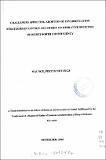| dc.description.abstract | The rate of adoption of diversification strategies by Sacco's is considered to be facing huge predicaments. This study addresses the challenges affecting the adoption of diversification strategies by Sacco's in Imenti-North Constituency, Meru- Kenya. The study sought to look into the following objectives: - To investigate the effect of risk, competition, technology, and nature of service offered on the adoption of diversification strategies by savings and credit cooperative organizations in Imenti-North Constituency. The financial institutions in Kenya have rapidly expanded as depicted by the increased number of players venturing into the financial market which has led to increased competition. Not only has the number of players increased, but also there is an increased variety of products and service offered. The following theories were applied in this study Igor Ansoff Matrix, Organizational Adoption, Modem Portfolio Theory and Porter's Theory of Competitive Advantage. This review aids in the understanding of the concept of product diversification in the financial institutions especially the Saccos. The target population for this research included all the 35 Saccos in Imenti North Constituency, Meru County. The 35 Sacco's represented the researcher's units of analysis from North Imenti which is the chosen research area. The total number of the possible respondents for the research comprised of all the board members of these Saccos. The researcher used a census survey which implies that all the units of study (Saccos) participated. The total number of possible respondents was 315 which was the total number of all board members of the 35 Saccos in North Imenti. The researcher selected purposively three board members from each Sacco which comprised of the managing director and two non-executive board members. These formed a total of 95 respondents. The• collected data from the questionnaires was organized starting with the coding of the question items, then coded data was transformed into descriptive statistics( frequencies, means, and standard deviations)with the aid of statistical packages for social sciences(SPSS version 22). Multiple logistic regression was used to link the relationship between the dependent variable (adoption of diversification strategies by Saccos) and the independent variable (risk, technology, competition and nature of service offered) and to test the hypothesis at 95% confidence level using Wald test aided by spss (version 22). Ninety-Five (95) questionnaires were distributed to the various respondents in the 35 sampled Sacco's. Seventy-six (76) were returned representing a response rate 80%. Purposive sampling was used to select respondents from each stratum to form a sample size of 35respondents. Data were summarized and presented in the form of frequency tables and percentages. The findings revealed that the model as a block was found to be a significant predictor based on the omnibus test. From the results, all of the study variables were considered by the respondents to be significant apart from a risk which ranked the lowest. Therefore technology enhancement and competition be classified as the strongest predictors of adoption of diversification. Sacco's should embrace and strongly support diversification because from the study we can see how firms are benefiting from the use of diversification like increased market share, security advancement and automation of systems which leads to efficiency and effectiveness which encourages brand loyalty. Therefore, it is recommendable that the management should understand the importance of these study variables which refers to the top management's strategy about innovativeness and risk-taking for the sustainability of the Sacco's. | en_US |

